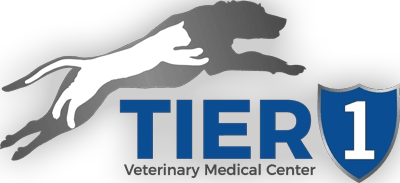Diagnosis: Squamous cell carcinoma
Treatment: Nasal planectomy
Cancer of the Nose
Tumors can occur anywhere in the bodies of our canine and feline friends, including the nose. Some tumors occur in the external (or visible) part of the nose, while others occur deeper within the nasal cartilage where they cannot be seen from the outside. A tumor may cause repeatable bloody noses (like in Beau’s case). They may also cause sneezing, pain, a lack of appetite, and snorting or other nasal sounds.
If a tumor is not visible, a video scope can be placed up the nose (called a rhinoscopy) to look for problems higher up. A biopsy is performed to sample a suspected tumor and help guide the decision-making process. Beau’s tumor is called a squamous cell carcinoma. This type of tumor is often found in the nose, mouth, and toes. They can be very locally aggressive. However, spread of the tumor is less common and generally not seen until late in the disease process.
Beau had a CT scan of the head performed to assess the extent of the tumor. When possible, surgical removal of a nasal tumor is the treatment of choice. If surgery cannot be performed, then radiation therapy and chemotherapy may be options to consider instead.
What is a Nasal Planectomy?
The hairless, wet, pigmented part of a dog’s external nose is called the nasal planum. Beau’s tumor was inside his right nostril within this nasal planum. The nasal planum can be partially, or completely, removed as needed when a tumor is present. Removing the tumor is the first step. Reconstructing a “new” nose is the second step.
When a complete nasal planectomy is performed, a significant change in appearance is expected. Sometimes the skin is sutured directly to the opening of the inner nasal cartilage creating a “pig snout” appearance. Other times (like with Beau), the lips are pulled upward and used to create a “new” nose. The lips help protect the inner nasal turbinates from debris, dirt, and drying out.
Life Without a Nose.
Our pets are amazing! They do not carry around self-pity like people do. They can adapt remarkably quickly to an outward physical change or loss of a body part. Beau is still able to sniff, smell, breathe and eat. He is happy and currently cancer free.
Dr. Vanessa Serratore
Dr. Vanessa Serratore is the Residency-Trained Surgeon at Tier 1 VMC. She completed her residency in small animal surgery at MedVet in Columbus, OH, and has travelled around the country in pursuit of her training. Dr. Serratore performs orthopedic, soft tissue, and neurological surgeries at Tier 1 VMC. We hope your pet never needs these services, but rest assured that we are here to help if the need arises.
